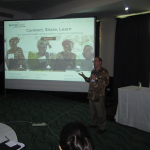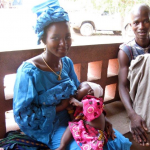Innovations and New Approaches for SBCC Capacity Strengthening: Webinar Recap
What is capacity strengthening, and how do we build social and behavior change communication (SBCC) capacity at the organizational and individual levels? Three experts answered those questions and more during HC3’s “Innovations and New Approaches for SBCC Capacity Strengthening” webinar on May 28.
Kim Ahanda, Senior Behavior Change Advisor at USAID, provided an overview of capacity strengthening, emphasizing its procedural and holistic nature. She discussed the three levels of capacity strengthening: individual, institutional, and societal or environmental. The core of capacity strengthening, she noted, is sustainability. Communication is most effective and sustainable when designed, implemented and evaluated locally, which requires country ownership and an adequate skill base.
Ahanda highlighted a few of HC3’s tools designed to build local SBCC capacity:
- Health COMpass: a “best of the best” collection of SBCC capacity strengthening tools and examples
- Springboard for Health Communication: a virtual platform with face-to-face elements that connects SBCC professionals, allowing them to share ideas, resources and learn together
- SBCC Virtual Leadership Development Program: a six-month online course that mentors teams as they overcome SBCC challenges by applying leadership and management principles
Sylvia Vriesendorp, Global Technical Lead for Leadership and Management at MSH, focused on building organizational capacity, touching on the phases, areas and tools available for organizational capacity strengthening. Organizational capacity, she said, is all about resilience – the ability of an organization to manage its affairs successfully. She gave four reasons why we need to focus on organizational capacity:
- Individual capacity can walk out the door
- Feedback from colleagues and bosses, coupled with a supportive climate and processes, allows individuals to utilize their capacity
- Individual capacity can stagnate or deteriorate without opportunities to practice, which requires organizational resources
- Technical capacity alone is not enough for success
Organizational capacity can be built in a number of ways, including through mentoring and coaching, training and peer support. Vriesendorp highlighted some processes and tools MSH uses to strengthen organizational capacity: participatory organizational assessments, leadership development programs, stakeholder alignment meetings and planning organizational resilience.
Patricia Ajavon, Program Officer at JHU·CCP’s Cote d’Ivoire office, discussed her experience building individual capacity locally. Through a needs assessment, her team identified an SBCC capacity need in gender integration. She combed the Health COMpass for tools in French that would help build local capacity in gender integration and selected the ISOFI tool developed by CARE and ICRW. Using the five introductory exercises in the manual, her team held participatory workshops in Cote d’Ivoire with two local NGOs. The workshops allowed participants to examine their values, attitudes, beliefs and experiences about gender and sexuality so that they could better meet the needs of their beneficiaries.
Ajavon recounted the positive results of these workshops. Participants reported increased tolerance toward homosexuality, increased empathy, improved facilitation and communication skills with their audience, and a desire to mainstream gender in their activities.
Learn more about JHU·CCP’s use of the Health COMpass to build gender SBCC capacity in Cote d’Ivoire.
Webinar recording. Please note the webinar is in French.








Leave a Reply
Want to join the discussion?Feel free to contribute!